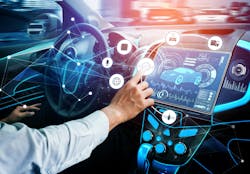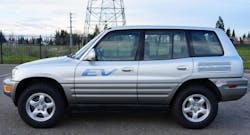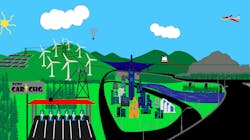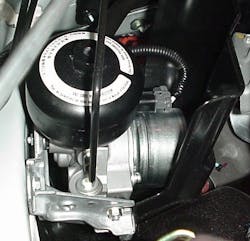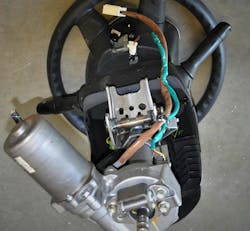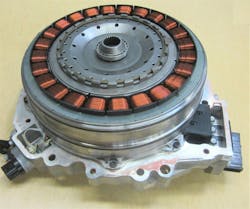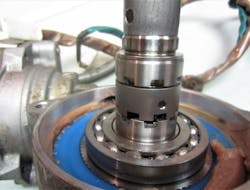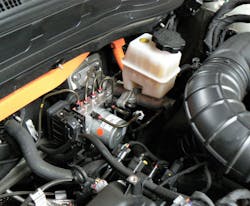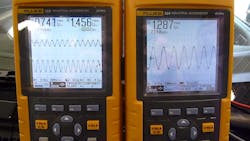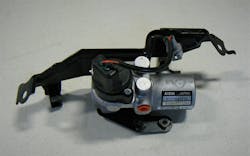Engineers have been improving automotive and truck systems for a very long time. My grandfather, Ed Finacom, used a team of horses to haul back electric cars when the batteries went dead over 120 years ago. My father, Raymond Van Batenburg, modified a 1950s Ford to look cool and go faster when I was a kid in Utah. That was a long time ago and as more cars and trucks hit the road, some of the fun turned into traffic accidents and polluted air. In 1970 the Environmental Protection Agency (EPA) was created and then the National Highway Traffic Safety Administration (NHTSA) started up the same year. These regulatory bodies are still here and their missions are to make the roads safer and the air, land and water cleaner. We have come a long way in my lifetime and even further since my mother’s father, Ed, started his job fixing electric cars. In the last hundred years, we have experienced an incredible array of innovations. Advanced Driver Assistance Systems (ADAS) came out of the last few decades. ADAS was influenced by the decades before. Let me make the case that hybrids made the transition to ADAS possible.
Toyota Prius History
The Toyota Prius started development in the late '80s. It was put on a fast track to go to market in Japan when Toyota was faced with Honda making them look technically inferior on the Indy Car and F1 race tracks. If the growth of Honda sales in Japan had continued, at some point in the future, the mighty Toyota would have become the No. 2 best-selling brand and Honda No. 1 in Japan. The proud Toyoda family would never let that happen. Once the Japanese unspoken rule “never work for the competition” started to fade away, Toyota hired talent that they lacked from many OEMs and started a top secret project. That project eventually produced the Prius.
The first Prius was sold in Japan in December, 1997 as a M/Y 1998 and it was a hit, but Toyota only made a right hand drive model. Toyota management asked the R & D team to convert the Prius to left drive and beat Honda to the punch as Toyota had already sold over 35,000 Prii in Japan and the technology was working fine. Soon a problem was sent back to Toyota management from R & D. They couldn’t just move the steering wheel from right to left without re-designing a large part of the car. It would take more time than Toyota had, if they wanted to sell the first hybrid in the U.S. The car was eventually redesigned for the U.S. market. It was much quieter, faster and better appointed than the Japanese model.
My thanks to the late Stan Stephenson (former editor of Motor Age) as he was able to get me my first test drive in a Japanese version, right hand drive Prius, in the fall of 1999. The U.S. Prius was made available to the public in the summer of 2000 as a M/Y 2001, and was in limited supply. It became the iconic hybrid.
Toyota Early RAV4 EV
If you lived in California in 1997 you could apply to lease a pure electric Toyota RAV 4. Using Nickel Metal Hydride batteries and a Denso-designed heat pump, this heavy and slow EV (zero to 60 in 18 seconds) was also being designed by Toyota at the same time the Prius was just coming out. We have an old RAV4 EV at ACDC (my HEV-EV technician training company). The '90’s were busy as OEMs were required to sell zero-emission vehicles in some states. It pushed the advancement of many ADAS components we see today.
Electric Power Steering
In 1988, Koyo Seiko and NSK co-developed a column mounted system 12-volt motor that assisted a manual rack and pinion system used on small cars sold in Japan. The first-ever electric power steering system (EPS) for mass-produced passenger cars appeared on the Suzuki Cervo in 1988. In 1993 the Acura NSX offered an A/T as an option and the added weight required a power steering system so Acura brought EPS to America.
Today, EPS is the norm in most new, light duty vehicles. The Ford F-150 and the Chevy Silverado half-ton pickup trucks have used a 12-volt electric power steering system for almost 15 years. Because hybrids need EPS so the ICE (internal combustion engine) can shut down at idle, this need drove the development of EPS.
Automatic Braking
The basic concept of regenerative, or recuperative braking, is to hold off using the conventional hydraulic brakes and let the drive wheels slow the HEV down using the high voltage drive motor(s) as a generator. Without modern computer controls, that would not have been possible. Imagine only having front brakes and trying to stop a car in all conditions. That would be very dangerous as the rear wheel brakes are needed to add stability. To have a computer stop the vehicle with both a hydraulic system (think of a four-channel ABS system) and one or more generators in the drive line, the Hybrid or EV would need the following data:
- Speed of each wheel
- Speed of the vehicle
- Stopping force requested
- Actual “G” force in real time
- Yaw rate
- Hydraulic pressure at each wheel
- Exact position of the brake pedal
- Brake fluid pressure in the master cylinder
- Pressure in the accumulator
- Vacuum in the brake booster (if equipped)
- How fast the driver pressed the brake pedal
- State-of-charge of the high voltage battery pack
- Other data may also be used
A smart dedicated computer system would stop the vehicle safer and faster than the average human.
ADAS Today
Advanced Driver Assistance Systems (ADAS) technologies hold the potential to reduce traffic crashes and save thousands of lives each year. In 2022, 42,514 people died in motor vehicle crashes in the U.S. Many of these crashes were tied to human error.
Passive ADAS
A passive ADAS function merely informs the driver of an unsafe condition. The driver must take action to prevent that condition from resulting in an accident. Typical warning methods include sounds and flashing lights, and sometimes even physical feedback, for example, a steering wheel or seat that shakes or vibrates.
Common passive ADAS functions include:
- ABS or Anti-lock Braking Systems prevent the vehicle from skidding and allow turning when emergency braking is needed.
- ESC or Electronic Stability Control will assist the driver if they are losing control in an under or over-steering situation, usually when driving excessively fast.
- TCS or Traction Control System uses both ABS and ESC to assist the driver in maintaining adequate traction when negotiating turns, on hard acceleration or other times when the wheels are losing grip.
- A Back-up Camera provides the driver a view behind the car when parking and backing up, and some vehicles allow the camera to be activated while driving forward.
- LDW or Lane Departure Warning alerts the driver if the vehicle is not keeping within its lane.
- FCW or Forward Collision Warning tells the driver to brake in order to avoid a collision ahead.
- BSD or Blind Spot Detection warns the driver that there is a vehicle in their blind spot.
-
Parking Assistance will warn the driver when their front or rear bumpers are approaching an object at low speeds, i.e. when maneuvering into a parking space.
Active ADAS
An active ADAS function will allow the vehicle to take direct action.
Examples of active ADAS functions include:
- Automatic Emergency Braking will stop or slow down the vehicle as required to avoid hitting a vehicle ahead or another object, including pedestrians, animals, or anything in the lane of travel.
- Emergency Steering takes over the steering of the car to avoid striking an object in the lane of travel.
- Adaptive Cruise Control keeps a safe distance, when activated, from the vehicle ahead of you. It will adjust your speed to match that of the vehicle in front of you.
- Lane Keeping Assist (Sometimes called Lane Centering) will steer your car to stay centered in your lane.
- Traffic Jam Assist combines Adaptive Cruise Control and Lane Keeping Assist to provide semi-automated driving in dense traffic events, i.e., stop-and-go conditions due to lane closures, road construction, etc.
-
Self-Parking will help those who never learned how to park a car maneuver into a parking spot.
Fully Autonomous ADAS Technology
The ultimate extension of ADAS technology is full autonomy, i.e., self-driving capability. (A common acronym is AV, for “Autonomous Vehicle.”) If we imagine a future world where cars, trucks, motorcycles, mopeds, and buses are driving around without human operators in control, the challenges involved in creating such a broad system of automated driving technologies seem daunting.
If we can get there, here are some benefits:
- Far fewer accidents caused by driver error, meaning fewer human injuries and death, as well as fewer damaged or destroyed vehicles and property.
- Lower energy consumption due to ride-sharing, and possibly even fewer cars needed per capita.
- Self-managed traffic systems on busy roads, meaning fewer traffic jams.
-
Less stress and road rage, leading to a more peaceful world.
What the Future May Hold With Advanced ADAS and EVs.
Consider this: It is 2044 and most cars are battery powered electric cars. The fuel cell was tried but the infrastructure was never built out so the few fuel cell cars from the 2020s are sitting behind a repair shop and the owner is still thinking about the cost for a new fuel cell membrane rebuild kit. Hydrogen is expensive and although you can still buy it, the stations are getting harder to find, just like gasoline. Diesels started to go out of favor in 2016 when Volkswagen brought attention to how dirty they can be and VW switched to all electric vehicles (EVs) in 2033. Volvo had shocked everyone in 2017 with their announcement that they would stop spending any more research dollars on the internal combustion engine. In 2029 Volvo became a leader building pure EVs in China. All major cities across America started switching their city vehicles to pure EVs by 2028. Recharge times were no longer an issue as the 4-to-10 minute wait for a city car that had a 200 mile range or a 15 minute charge gaining you 500 miles of range was acceptable. The high voltage battery packs are leased to the car owners by Exxon Mobile or some large energy producer that uses intermittent sources like wind and solar. The packs are repurposed, after their useful life in the car is over, to store electricity at wind and solar farms. Body shops will have little work to do as traffic accidents are so rare. The work is mostly restoration for people yearning for the good old days when cars ran on gasoline and humans had to drive them.
As each advancement adds collectively to a more complex machine, it may feel like we are driving around in a laptop with a windshield and four wheels. Did the Prius get us to ADAS? I say yes, but many cars came before the Prius. The problems that so many vehicles have brought us also gave us mobility, the middle class, and jobs.
Technology, and your ability to fix these semi-automated systems, will get us to a better future. If you have mobility challenges, use a wheel chair, or need help walking, there is good news in all this. My late friend, Marylyn Keer, used a handicapped van for the last 20 years of her life. She made the best of it and drove the van herself as long as she could. If you are a new technician entering the workplace, keep up your studies, as we will need you to fix a broken world along with broken cars and trucks.
About the Author

Craig Van Batenburg
Craig Van Batenburg is the CEO of ACDC, a hybrid and plug-in training company based in Worcester, Mass. ACDC has been offering high voltage classes since 2000, when the Honda Insight came to the USA. When EVs were introduced in 2011, ACDC added them to their classes. Reach Craig via email at [email protected] or call him at (508) 826-4546. Find ACDC at www.FIXHYBRID.com.
